PHYSICAL ENVIRONMENT AND HUMAN ACTIVITY
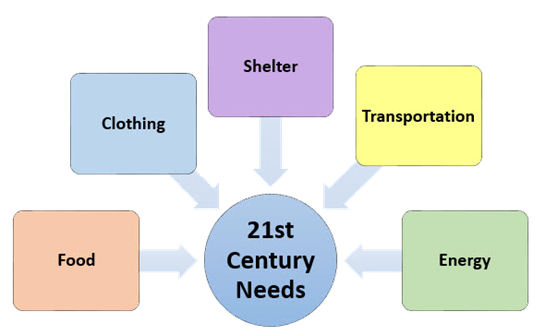
Unit
Overview
Across
the Eastern Hemisphere, people live and work in a wide variety of physical
environments. Some regions have rugged
mountains and cold climates. Others experience
warm temperatures throughout the year and very little rainfall. Nonetheless, everyone has certain basic needs
that must be met. In this unit, you will
learn how people adapt to their environments and find ways to fill their basic
needs within their surroundings. Let’s
get started!
Physical
Environment Influences Human Activity
Although
many of us like where we live, no place is perfect. For this reason, people are always looking for
ways to adapt to their physical environment. The goal is to make their lives
better. A physical environment consists of all the factors of nature present
in a particular area. These include
landforms, waterways, soil conditions, climate, natural resources, plant life,
and animal life. Our physical
environment influences our human activities.
Human activities are the
things that we do to help us meet our needs and enjoy our lives. In other words, where we live determines how
we live. Geographers call this
relationship between people and their surroundings human interaction. Although
not all human activities have had positive results, people have attempted to adapt
to their surroundings since the beginning of time. They do this to obtain not just what they
want but what they actually need to live and work in the 21st century. This includes food, water, clothing, shelter,
transportation, and energy.
What
We Really Need: Food and Water
If
people are going to survive, there are certain basic necessities that they must
have. One of these is food. Today, many countries meet this need through
world trade. As a result, some regional
differences in what people eat have disappeared over time. Nonetheless, populations in some areas of the
world still depend on what they can grow locally. Therefore, farmers grow and people eat what
they can produce within their physical environment. For example, the South Asian countries of India and Bangladesh are among the
world’s top producers of rice. For rice to flourish, it needs warm
temperatures and enough rain to create flooded fields called paddies. The physical environment of this region
provides both of these.

Wind
conditions here result in heavy rains, or monsoons,
in the summer months. Although they make the growth of rice possible, there is
no way to control the amount of water that arrives during the monsoons. Some years, they cause devastating floods and
loss of life. The video below describes
the effect of the monsoons on the Indian province of Meghalaya.
On
the other hand, places like eastern Russia,
Poland, and Ukraine have cooler temperatures and less rainfall. Here, the physical environment offers the
right conditions for growing wheat. Other places with even less rainfall are
better suited for grazing cattle and sheep.
Although they are too dry for farming, they provide enough rainfall to
support grasslands necessary for feeding animals. The physical environment of Australia and New Zealand has made
these nations of the South Pacific two of the world’s largest producers of
sheep. Similar conditions in East Africa provide the right environment
for herding cattle.
What We
Really Need: Clothing
Humans
also need clothing to protect them from certain aspects of their physical
environment. This influences the style
of dress throughout the Eastern Hemisphere.
It is another way that people adapt to the climate in which they
live. For example, much of North Africa
consists of the Sahara and Arabian
Deserts. Scientists have recorded
the Earth’s hottest temperatures here.
Berbers and Arabs, who live in this region, wear wide, loose clothing
made of white or light-colored material.
This reflects sunlight and provides ventilation for a cooling
effect. The inhabitants are also careful
to cover their heads and necks.
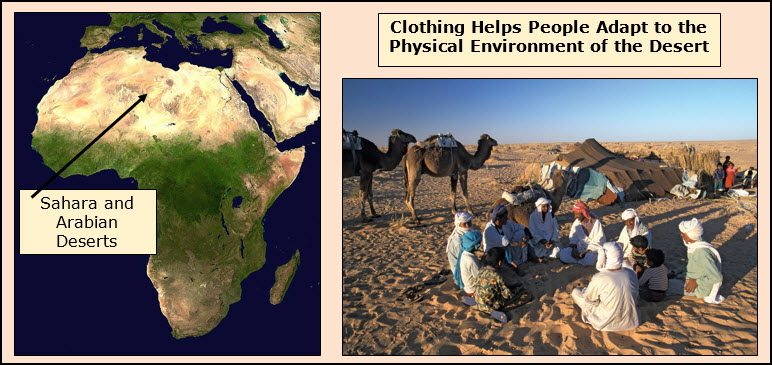
Vietnam,
located in Southeast Asia, also has very warm temperatures throughout most of
the country. Unlike the Sahara, rainfall
here is often heavy. Watch the video
listed below to learn how the Vietnamese have adapted their clothing to their
physical environment.
What
We Really Need: Shelter
Another
basic requirement for human survival is shelter. A shelter is a structure that provides
protection from anything that is harmful or threatening. Over the centuries, people have come to count
on these buildings for cover from the weather, security, and storage for food,
tools and other possessions. Today, we
think of them as our homes. The
materials used to build these structures are generally found in an area’s
physical environment. For example, in the
African country of South Sudan, there is not enough rainfall to
produce lumber for the construction of houses.
There is, however, enough moisture to grow grass. The people can not only raise livestock, but
they can also use the grasses as building material. This results in the grass huts pictured below.
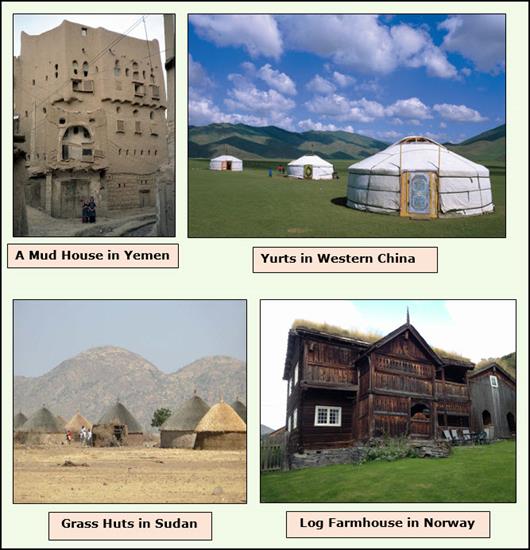
1Images of Sudan and Norway courtesy of Bernard Gagnon and Øyvind S.
Johanse
The
cool, dry climate of Mongolia permits
the growth of grasslands but does not support forests. Bordered by China on the south and Russia on
the north, this is another place where only a small supply of wood is available
to build homes. Because the grasslands
are well-suited for raising animals, herders frequently move from one grazing
area to another. For these reasons, the
people who live here need houses that are moveable and use only a small amount
of lumber. Yurts fulfill both
requirements. These large, round tents
are formed around a few wooden poles tied together with ropes. They are covered with hides, felt, and
canvas. In a few hours, they can be
dismantled and rebuilt on another site.
Watch the video below to learn more about yurts and how the area’s
physical environment influences the lives of Mongolians.
Yemen, a nation located in the Middle
East, has some dry areas with few resources for construction. People here have adapted by making bricks
from mud and straw. You might be
surprised to learn that they are able to build homes with several stories like
the one pictured above. People living in
countries with short summers and colder temperatures require shelters that protect
them from ice and snow. Northern Europe, for example, has the
physical environment that supports forests and supplies timber. For this reason, log homes, like the
Norwegian farmhouse pictured here, are common.
What
We Really Need: Transportation
Transportation
is the process of moving something or someone from one place to another. It is necessary because not all the items or
living conditions that people need and want are within their reach. Therefore, they have to move themselves or
move things to them. Today, airplanes,
ships, cars, and trucks are present everywhere in the world. In fact, these forms of transportation are so
common that we often take them for granted.
Can you imagine what travel was like before mechanized transportation
existed? In earlier times, people used
water and wind to get from one place to another. A region’s physical environment determined
its access to water routes and times of the year most suitable for travel. For example, the ancient Greeks, who lived on
a peninsula with miles of coastline, sailed from one city-state to another to
trade. The Vikings of Northern Europe also lived on a peninsula and traveled
far from home on longboats equipped with
sails.
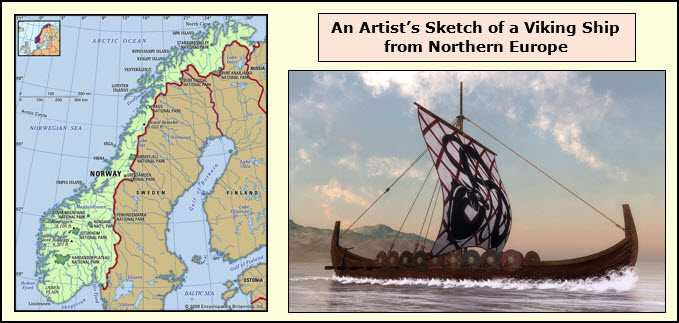
For
centuries, people relied on animals to provide overland transportation. The animals that did this work were the ones
that survived best in their physical environment. Caravans of camels crossed the deserts and
carried goods from Asia to Europe. Camels did not need water as frequently as
other animals. Their padded feet protected
them from the desert heat, and long lashes kept the blowing sand out of their
eyes. In other areas of the Eastern
Hemisphere, horses proved to be the
best means of transportation. Along with
oxen, Europeans also used them to
pull plows and to carry heavy loads to market.
In India, elephants
transported people and performed tasks that required strength and
intelligence. In the twenty-first
century, they continue to transport crops and lumber.
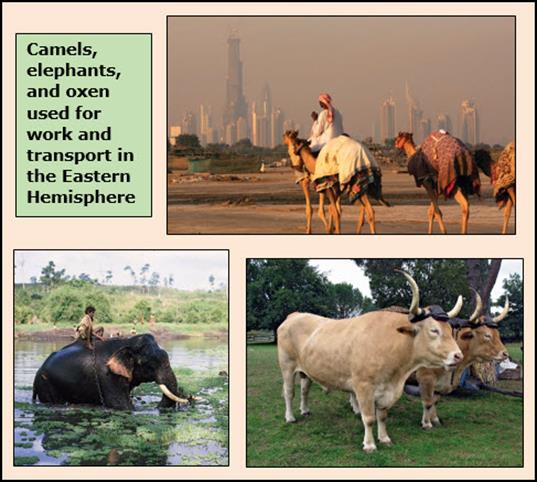
What
We Really Need: Energy
If
nations are going to develop industries, they need sources of energy. Some forms of energy, such as wind, water,
and sunlight, are renewable. This means that they will always be available
no matter how much people use them. Nonrenewable resources, on the other hand,
cannot be replaced, at least not for millions of years. This group includes coal, natural gas,
uranium, and oil. Like other resources,
sources of energy are not distributed evenly around the world. For example, the Middle Eastern nations of Saudi Arabia and Iraq produce more oil
than they use. However, many other
nations, such as Japan and the United
Kingdom, consume more oil than they produce. These countries must buy oil from others or
look for alternative sources within their own physical environments.
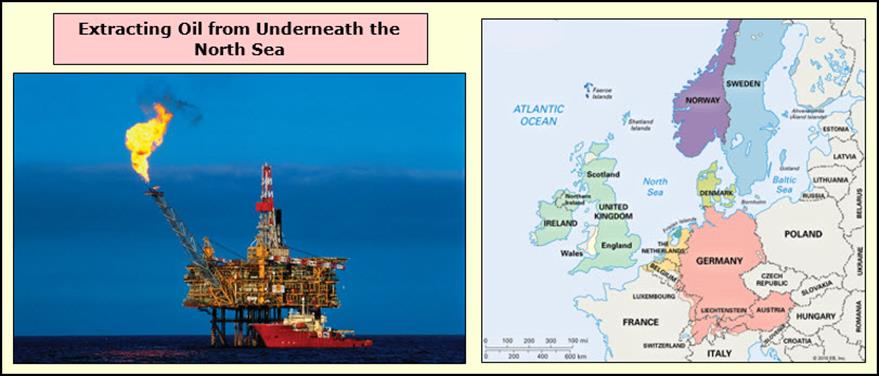
The
search for alternative sources of energy has encouraged the nations of the
Eastern Hemisphere to explore several options.
In the 1970s, countries bordering the North Sea began to drill
for oil and natural gas underwater.
Today, offshore rigs like the one pictured above stretch four hundred
miles across this body of water. The
North Sea has not only become Europe’s most important oil and natural gas
producer but has also decreased the region’s dependency on foreign oil.
In
an attempt to use less coal, China
has invested in turbines like those pictured below to create electricity by
harnessing the wind. The Gansu Wind Project is on track to
become the world’s largest wind farm. The Chinese government has announced that
it expects wind power to be an
important factor in the growth of the nation’s economy over the next decade. Not all wind turbines operate on land. The United Kingdom has placed a series of 175
turbines in the English Channel. Known
as the London Array, it is the
world’s largest offshore wind farm.
Learn more about this project by watching the video listed below.
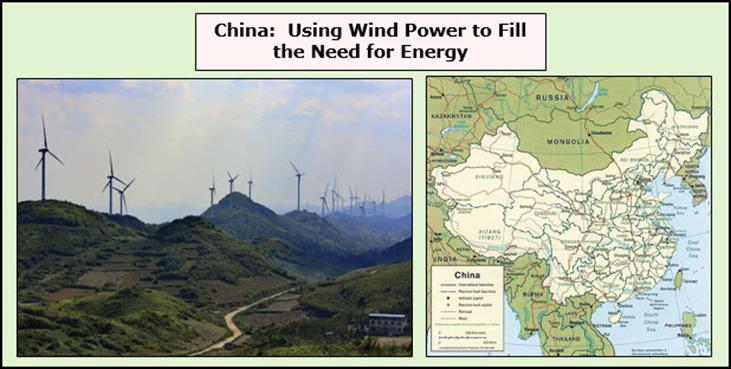
Time
for a Quick Review
Before
moving on to Unit 5, take a few minutes to review the terms found in Unit 4. Be sure that you can answer the “Can I”
questions listed here with a loud “yes”.
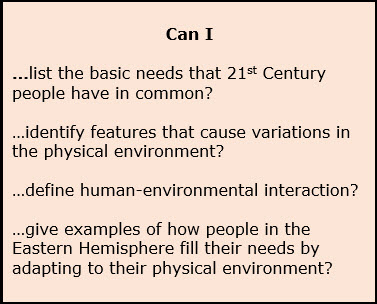

Additional Activities and Resources
In the
coldest village on Earth, eyelashes freeze and dinner is frozen (article and quiz courtesy of Newsela)